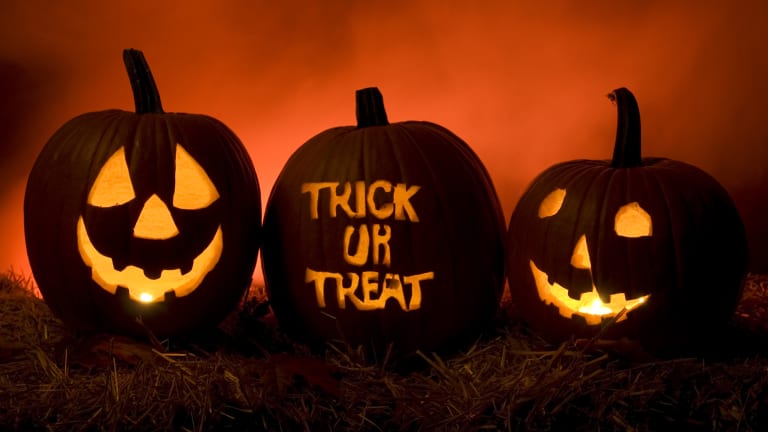"Halloween originates from the ancient Celtic festival of Samhain."--7th grade lana richard
Halloween originates from the ancient Celtic festival of Samhain. People would light bonfires and wear costumes to ward off ghosts. On the night of October 31st it was believed that the ghosts of the dead returned to Earth, in addition to causing trouble and damaging crops.
According to history-of-halloween, the Celts thought that the presence of the otherworldly spirits made it easier for the Druids, or Celtic priests, to make predictions about the future. To celebrate the event, Druids built huge sacred bonfires, where people gathered to burn crops and animals as sacrifices to the Celtic deities. During the celebration, the Celts wore costumes, usually of animal heads and skins, and attempted to tell each other’s fortunes.
By 43 A.D., the Roman Empire had conquered most of the Celtic territory. In the time of the 400 years they ruled the Celtic lands.
Two festivals of Roman origin were combined with the traditional Celtic celebration of Samhain. The first was Feralia, a day in late October when the Romans traditionally celebrate the passing of the dead. The second was a day to honor Pomona, the Roman goddess of fruit and trees. The symbol of Pomona is the apple, this part celebration into Samhain probably explains the tradition of bobbing for apples that is used today on Halloween.
Halloween’s origins date back to the ancient Celtic festival of Samhain. The Celts, who lived 2,000 years ago. In the area that is now Ireland, the United Kingdom and northern France, celebrated their new year on November 1. This day marked the end of summer and the harvest and the beginning of the dark, cold winter, a time of year that was often associated with human death. Celts believed that on the night before the new year, the boundary between the worlds of the living and the dead became blurred. On the night of October 31 they celebrated Samhain, when it was believed that the ghosts of the dead returned to earth.
Halloween Comes to America
The celebration of Halloween was extremely limited in colonial America, for example New England, because of the belief systems there. Halloween was much more common in Maryland and the southern colonies.
Jack O’Lanterns
According to history-of-the-jack-o-lantern, pumpkins did not exist in Ireland. Ancient Celtic cultures in Ireland carved turnips on All Hallow's Eve, and placed an ember in them, to ward off evil spirits. The practice of decorating jack-o’-lanterns. The name comes from an Irish folktale about a man named Stingy Jack, which you can read more about here osatelegraph.org. Irish immigrants brought the tradition to America, home of the pumpkin, and it became an integral part of Halloween festivities. In Ireland and Scotland. People began to make their own versions of Jack O’Lanterns by carving scary faces into turnips or potatoes and placing them into windows or near doors to frighten away Stingy Jack and other wandering evil spirits.
According to history-of-halloween, the Celts thought that the presence of the otherworldly spirits made it easier for the Druids, or Celtic priests, to make predictions about the future. To celebrate the event, Druids built huge sacred bonfires, where people gathered to burn crops and animals as sacrifices to the Celtic deities. During the celebration, the Celts wore costumes, usually of animal heads and skins, and attempted to tell each other’s fortunes.
By 43 A.D., the Roman Empire had conquered most of the Celtic territory. In the time of the 400 years they ruled the Celtic lands.
Two festivals of Roman origin were combined with the traditional Celtic celebration of Samhain. The first was Feralia, a day in late October when the Romans traditionally celebrate the passing of the dead. The second was a day to honor Pomona, the Roman goddess of fruit and trees. The symbol of Pomona is the apple, this part celebration into Samhain probably explains the tradition of bobbing for apples that is used today on Halloween.
Halloween’s origins date back to the ancient Celtic festival of Samhain. The Celts, who lived 2,000 years ago. In the area that is now Ireland, the United Kingdom and northern France, celebrated their new year on November 1. This day marked the end of summer and the harvest and the beginning of the dark, cold winter, a time of year that was often associated with human death. Celts believed that on the night before the new year, the boundary between the worlds of the living and the dead became blurred. On the night of October 31 they celebrated Samhain, when it was believed that the ghosts of the dead returned to earth.
Halloween Comes to America
The celebration of Halloween was extremely limited in colonial America, for example New England, because of the belief systems there. Halloween was much more common in Maryland and the southern colonies.
Jack O’Lanterns
According to history-of-the-jack-o-lantern, pumpkins did not exist in Ireland. Ancient Celtic cultures in Ireland carved turnips on All Hallow's Eve, and placed an ember in them, to ward off evil spirits. The practice of decorating jack-o’-lanterns. The name comes from an Irish folktale about a man named Stingy Jack, which you can read more about here osatelegraph.org. Irish immigrants brought the tradition to America, home of the pumpkin, and it became an integral part of Halloween festivities. In Ireland and Scotland. People began to make their own versions of Jack O’Lanterns by carving scary faces into turnips or potatoes and placing them into windows or near doors to frighten away Stingy Jack and other wandering evil spirits.


